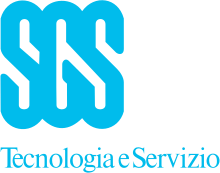 | |
| Company type | Public |
|---|---|
| Industry | Semiconductor industry |
| Founded | 1957 |
| Founder | Olivetti and Telettra |
| Defunct | 1987 |
| Fate | merged with Semiconductor branch of Thomson SA |
| Successor | STMicroelectronics |
| Headquarters | Agrate Brianza, Lombardy, Italy[1] |
Area served | Europe, Americas, Asia–Pacific |
SGS (Società Generale Semiconduttori, English: General Semiconductor Company) was an Italian manufacturer of semiconductor devices, most notably diodes, transistors and DIP ICs.
History
[edit]In 1957, Mario Tchou, an engineer from Olivetti, convinced Adriano Olivetti to found an Italian electronic manufacturing company for production of solid-state electronic devices. Olivetti sends his son Roberto Olivetti and Mario Tchou to negotiate with Virgilio Floriani, president of Telettra, to establish a joint venture. Within the same year, Olivetti and Telettra found Società Generale Semiconduttori (SGS).[2] One of the reasons for SGS's foundation is the need of parts (diodes and transistors in particular) for Elea, a mainframe that was being developed by Olivetti. Headquarters of the company was located in Agrate Brianza.[3]
In 1960, Fairchild Semiconductor acquired one third of the company and a joint venture called SGS-Fairchild got formed. That gave SGS access to Fairchild's newly invented planar manufacturing technology.[4] The partnership ended in 1968 and Fairchild sold its SGS stocks to IRI-STET, predecessor of TIM.
On December 1971, SGS merges with ATES and forms SGS-ATES. On 23 April 1985, the company changes its name to SGS Microelettronica. 2 years later, SGS Microelettronica merges with Thomson Semiconductors to form SGS-Thomson, which later becomes STMicroelectronics in 1998.[3]
See also
[edit]References
[edit]- ^ SGS-ATES (1983). SGS 25 anni (brochure).
- ^ Giuseppe Rao. "La sfida al futuro di Adriano e Roberto Olivetti. Il Laboratorio di Ricerche Elettroniche, Mario Tchou e l'Elea 9003". Mélanges de l'École française de Rome. Italie et Méditerranée. 115.
- ^ a b Salvatore Torrisi (2002). Imprenditorialità e distretti ad alta tecnologia: teoria ed evidenza empirica. Milano: Franco Angeli. p. 168.
- ^ Malerba, Franco (1985). The semiconductor business : the economics of rapid growth and decline. Internet Archive. Madison, Wis. : University of Wisconsin Press. ISBN 978-0-299-10460-3.